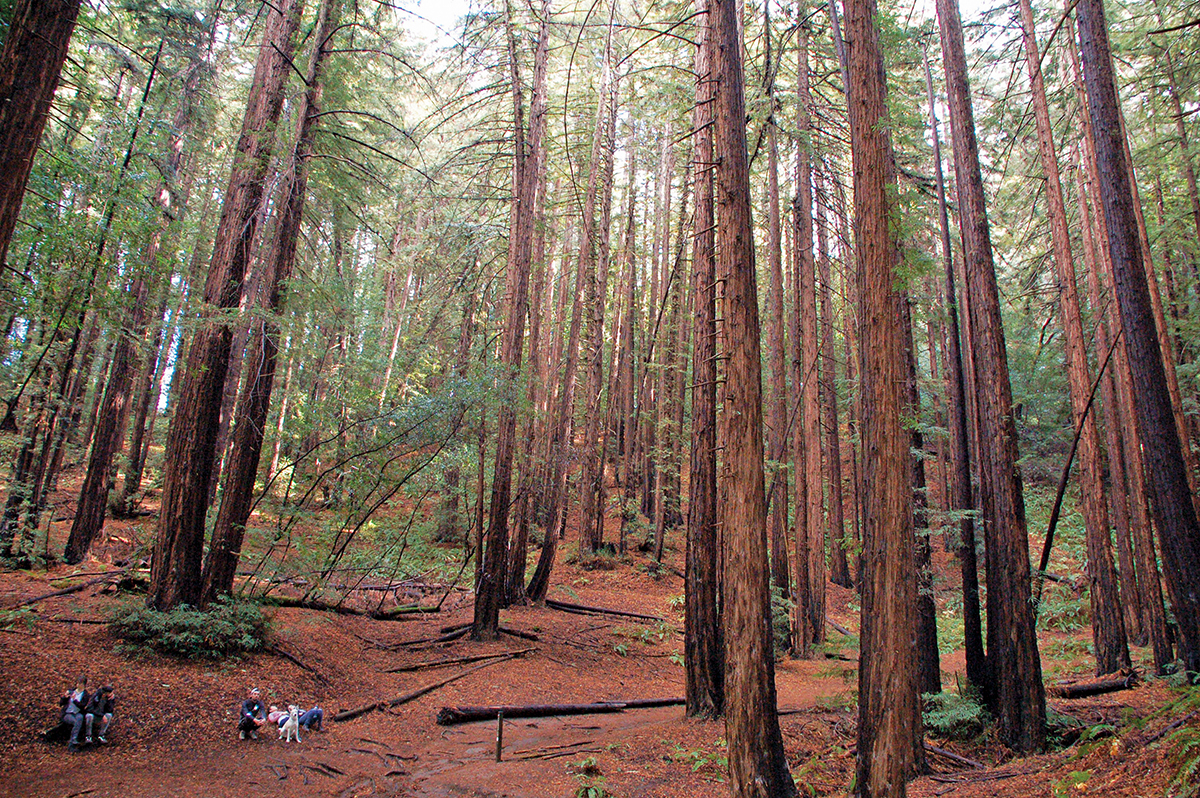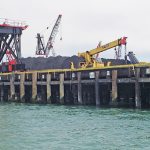
The Redwoods and Climate Change Initiative’s newest plot is in Redwood Regional Park. Photo by Alec MacDonald.
In late October, a small group of researchers descended on a rectangular plot in Redwood Regional Park, a popular hiking spot in the East Bay Regional Park District just a few miles from downtown Oakland. The park has the largest remaining natural stand of coast redwoods in the East Bay, and is the closest coast redwood forest to an urban center in the region.
The one-hectare plot is the first of 30 locations in a planned expansion of the Redwoods and Climate Change Initiative (RCCI), a research program designed to learn about the effects of climate change on redwoods. The expansion will allow scientists to study younger forests and how they respond to climate change. Save the Redwoods League leads the endeavor in partnership with researchers from Humboldt State University and the University of Washington.
During the first phase of the program, RCCI established 16 research plots in old-growth coast redwood and giant sequoia forests between 2009 and 2012. Five years after each plot was established, the researchers remeasured and inventoried trees and all vegetation to check mortality and growth, said Emily Burns, director of science at Save the Redwoods League. All 16 plots are permanent and will be monitored regularly, including two in the San Francisco Bay Area. One plot is in Big Basin Redwoods State Park and the other in Samuel P. Taylor State Park, which has the tallest coast redwood trees in the northern Bay Area. The other 14 plots are throughout California in the coast redwood and giant sequoia ranges.
Giant sequoias and coast redwoods are related, but have several notable differences. Redwoods are the tallest trees in the world and grow in a coastal belt 15 miles wide and 450 miles long from the Oregon border in the north to Big Sur in the south. Giant sequoias are the largest tree in the world by volume, and are restricted to a small range in Central California on the western slope of the Sierras between 4,000 and 8,000 feet. Both species grow only in California.
One of the things that researchers learned during the first phase of the project was that old-growth redwood forests store at least three times more carbon above ground than any other forest on earth. “It is high-quality carbon stored in heartwood that doesn’t decay even after the trees die,” said Burns. “We want to help [second-growth] forests be on a path to recover and regain the ecological functions of an old-growth forest.”
A healthy old-growth forest is better at filtering water, providing habitat, and storing carbon, she explained. Old-growth forests are those that reach a mature age without disturbance and with biological diversity and ecological functions intact. How old is old for these trees? Coast redwoods can live up to 2,000 years, and the oldest known specimen of a giant sequoia survived 3,266 years. Second- and third-growth coast redwood trees are those that sprout from cut trees after a timber harvest.
Prior to the Gold Rush and the population explosion in California, old-growth trees grew tall and strong in the area now known as Redwood Regional Park. Two of the tallest trees in what was then a roughly five-square-mile grove were used by captains to navigate hazards in the San Francisco Bay. First, many of the old-growth trees were felled to build Oakland and San Francisco. Then each time San Francisco burned to the ground in its early years, more lumber was taken from this grove to re-build. Just as the second-growth trees were acquiring some maturity, they were cut down to rebuild San Francisco after the 1906 earthquake and the fires it caused.
The researchers established their plot inside Redwood Regional Park, and then dangled from tree-climbing saddles to measure every branch of the tallest trees, mapped living and dead trees and other vegetation, and flew a drone to get imagery from above the treetops. As a result, they discovered something exciting that the East Bay Regional Park District hadn’t known, according to Kristen Van Dam, an ecologist with the agency. They found a patch of second-growth redwoods in a forest that had long been thought of as third-growth. “Any place loggers were able to reach easily, they logged more than once,” she said. “Humans did impact these forests before they were preserved, but now that the parks exist, they are preserved in perpetuity.”
The number of trees felled in the East Bay is just a small portion of the carnage that occurred throughout the coast redwood range. Prior to 1849, there were two million acres of old-growth redwoods in California. Today, only 5 percent of old-growth forests remain, and of the coast redwood forests that have endured, only 23 percent are protected, according to Save the Redwoods League.
But the logger’s axe is not the only threat facing redwoods today. These ancient trees must also survive air pollution, fragmented forests and habitat, invasive species, drought, and hotter fires.
The second phase of RCCI will establish 30 monitoring locations, some that will be one-hectare plots and others that will be individual trees. Other study sites in or near the Bay Area may include the Harold Richardson Redwoods Reserve in Sonoma County, the Archer Taylor Preserve in Napa County, and the Forest of Nisene Marks State Park in Santa Cruz County, said Burns.
The research gathered in younger forests with more extreme habitats, coupled with the ongoing monitoring of old-growth forests, will provide a wealth of information about the health of the trees and their forests. “We want to know which locations will be refuges for redwoods and where they are not doing as well, to make better stewardship decisions and help guide management,” said Burns.
There are many reasons to admire the coast redwood. Not only are they the tallest trees in the world, but they are also resilient, said Burns. They can survive being struck by lightning, hit by other trees, swept by fire, exposed to ongoing drought, and cut to the ground. “They really are sempervirens, or ever-living,” said Burns.
Most people think of coast redwoods as being only on the coast, she added. But the plots in the RCCI look at trees and forests in the north and south, and in coastal and inland areas. “Redwoods survive, and even thrive, in different temperature and water regimes, and that gives me hope that the species will be able to tolerate more changes in the future,” she said.
In fact, researchers found during the first phase that some of the old-growth trees have grown faster in the last 40 years than they ever have, perhaps due to longer growing seasons or less fog and more sunlight, both of which are conditions of a changing climate.
With only a small percentage of old-growth remaining, and their genetic diversity compromised as a result, California’s state tree needs our help to survive the changes that are coming. “We have to step up our game to ensure that these world-class forests are going to be around for generations to come,” said Burns.
Aleta George covers open space for the Monitor.

